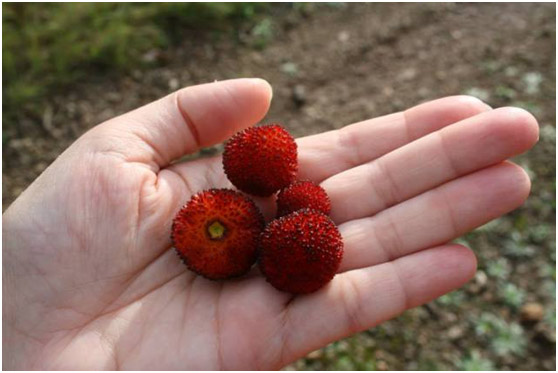Wild Edible Greens – Horta
Wild greens have been, and still are, the main food to sustain people in Greece. Wild edible greens and bread (when possible!) have helped people survive through centuries of wars and poverty.
Bread is holy food where I come from. What’s more, my grandfather had a mill to grind the wheat into flour, together with a bakery in which to make and sell bread. As soon as the Nazis set foot in our little town during the Second World War, they occupied the mill and the bakery along with the main public buildings. The whole family had to bake bread for the German army, while stealing food from the Nazis was punishable by death.
Grandmother Athena never followed orders, setting an example for all of us, her children and grandchildren. An example to follow or to reject but impossible to ignore. Every day, my grandmother would go to the bakery to bring the daily serving of boiled wild harvested greens to sustain the men working long hours. Whenever possible, she would hide bread loaves in her long panted underwear, covered by her rich cloth folded dress. Either, no one ever noticed her or one of the German soldiers turned a blind eye. I don’t think we will ever find out. The point is that she brought the bread home, and with it sustained not only her family, but all the kids living nearby. Bread will always be holy food for me and will always have a special place on my table. May more people turn to cultivating the earth with respect and produce wheat and other cereals in ways that honor these plants that have sustained humanity for millennia.
After the war, life gradually went back to “normal”, at least as far as food was concerned. Normal means that people had more things than boiled greens served for lunch and dinner, although many families were in such poverty that horta remained their main food for many years to come.
Wild greens are so much connected with everyday life in Greece that they were never missing from our table when I was a child, no matter what the food was. It still remains the typical supper dish for all families living in the countryside. Water boiled wild greens sprinkled with olive oil and lemon juice, a cup of warm wild green broth, bread and olives.
Harvesting wild greens has always been a kind of therapy for most people: a socially accepted excuse to be alone in nature, to heal and nurture oneself by reconnecting with something deeper. For the women, it has always been their freedom to roam in the wilderness alone or with other women. It is their time alone and their time to reconnect with loved ones that are no longer in their lives, as for most people these moments hold the precious memories of the loved ones that taught them this skill. I still know many women in Corfu that are looking forward to the end of the tourist season and the beginning of the rains that will bring back their moments in nature to harvest wild greens.
Edible wild greens appear with the first autumn rains. They increase in number and variety during the winter and finish when the temperature goes up in spring and new plants pop up everywhere.
Wild greens are harvested during the basal rosette leaf stage. People carefully cut the leaves, being sure not to hurt the root. When the plants grow stems, most of the time they are no longer considered suitable for eating. However, this is not always the case, as for certain plants, the young shoots or the leaf tops are what people are after.
The following table contains the plants eaten on the island of Corfu as wild edible greens. Some of them are toxic in certain stages of growth and most of the time are eaten while very young. Others are eaten in very small quantities in mixtures with other greens or after being processed, usually by heat. Most of them, however, are absolutely safe. All of them are very nutritious and even toxic plants have properties that made them important in people’s diets. At least, in the past…
| English Common Name | Greek Common Name | Scientific Name | Notes on the Plant |
| Wild Carrot | Γριτσόρα | Daucus carota | Nontoxic. Can be easily confused with Hemlock. |
| Sonchus | Ζέγκουνας | Sonchus sp. | Nontoxic. Eaten also raw as salad. |
| Dandelion | Πρικαλίδα | Taraxacum sp. | Nontoxic. |
| Chicory | Κιχώριο | Cichorium sp. | Nontoxic. |
| Black Bryony | Οβριές | Tamus communis | Toxic. Only the young shoots are eaten. Beloved spring food. |
| Asparagus | Σπαράγγια | Asparagus sp. | Nontoxic. |
| Butcher’s Broom | Αγγελόνια | Ruscus aculeatus | Nontoxic. Young shoots |
| Reichardia | Λαγόψωμο | Reichardia picroides | Nontoxic. |
| Amaranth | Βλήτο | Amaranthus sp. | Nontoxic. |
| Bristly Oxtongue | Ζαχουλιά | Helminthotheca echioides | Nontoxic |
| Nettles | Τσουκνίδα | Urtica sp. | Nontoxic. The green leaf tops are eaten. |
| Mediterranean Hartwort | Μοσχολάχανο | Τordylium apulum | Nontoxic. Small quantities in green mixtures as an aromatic. |
| White mustard | Σινάπι | Sinapis alba | Nontoxic. |
| Spanish Golden Thistle | Σκόλυμπρος | Scolymus hispanicus | Nontoxic. |
| Mallow | Μολόχα | Malva sylvestris | Nontoxic. |
| European Black Nightshade | Στύφνος | Solanum nigrum | Toxic. The young shoots are eaten, always boiled well. |
| Chard | Σέσκλο | Beta vulgaris | Nontoxic. |
| Yellow Dock | Λάπατο | Rumex sp. | Small quantities in mixtures because of the oxalic acid. |
| Milk Thistle | Γαϊδουράγκαθο | Silybum marianun | Nontoxic. |
| Shepherd’s Purse | Καπσέλα | Capsella bursa – pastoris | Nontoxic. |
| Knautia | Κουφολάχανο | Knautia integrifolia | Nontoxic. |
| Borage | Φούρνελας | Borago officinalis | Small quantities in green mixtures. It contains Pyrrolizidine alkaloids. |
| Red Stem Stork’s Bill | Περδικονύχι | Erodium circutarium | Nontoxic. |
| Honesty | Λουνάρια | Lunaria annua | Nontoxic. |
| Grape hyacinth | Καλογήρια | Muscari commosum | Nontoxic. Eaten boiled with Asparagus and Black Bryony or in omelet. |
The commonest way to cook wild greens is to boil them in salted water. Most people drink the broth warm and serve the greens sprinkled with olive oil and lemon juice.
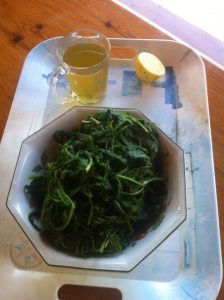
Another dish that most people in Corfu and the other Ionian islands adore is what is called tsigari or tsigareli. This is a pungent dish with aromatic wild greens, tomato sauce and plenty of hot pepper. The exact combination of wild greens used to make tsigari varies from family to family. The mixtures are complicated and I doubt there is anyone today that still knows why their forebears came up with them. There is a main green, safe and neutral in taste, that serves as the base of the dish and a great variety of wild plants in small quantities, sometimes even just one leaf. Some of them are certainly toxic in larger quantities but are probably balanced by centuries-old wisdom in the specific dish.
The recipe to make tsigari is the following:
- 1 ½ – 2 kilos of wild greens trimmed, washed and drained well. (To make a balanced and tasty tsigari wild green mixture is a real challenge!)
- 4 spring onions, chopped
- 1 bunch chopped fresh fennel leaves
- 1 bunch chopped fresh parsley
- 2 medium red onions, finely chopped
- 2 fresh tomatoes, chopped
- ½ tablespoonful tomato paste
- 3 garlic cloves, minced
- 1 cup olive oil
- 1 teaspoon cayenne pepper
- 2 teaspoons sweet paprika
- Salt and freshly ground pepper to taste
Blanch the greens for five minutes and drain well.
Heat the olive oil in a large skillet and cook the onions, the garlic, the parsley and the fennel leaves, stirring, over medium heat until soft, 5 to 7 minutes. Add the tomato paste, cayenne and paprika and stir for about 3 minutes. Add the wilted greens and the tomatoes. Simmer over low heat, uncovered, for about 20 minutes, until the greens are soft and all the pan liquids have cooked off. The dish should be fairly dry. Adjust the seasoning with salt and cayenne, and serve either warm or cold. Pour a little fresh olive oil over the greens once they are cooked, if desired.
Some of the people that shared the recipes they learned from their parents with me cook it with tomato and others don’t. The ones that don’t said that the dish owes its red tomato sauce color to the hot pepper in it. On the island of Kefalonia, where I come from, the recipe is the same more or less, but rice is added. My family’s recipe includes chopped orange peel for flavor and a unique aroma. On both islands, dried cod fish can be added on special occasions.
The following table contains the wild greens several local people I spoke with included in the tsigari mixture:
| English Common Name | Greek Common Name | Scientific Name | Notes on the Plant |
| Chard | Σέσκλο | Beta vulgaris | Nontoxic. Used as basic ingredient. |
| Spinach | Σπανάκι | Spinacia oleracea | Nontoxic. Used as basic ingredient. |
| Poppy | Παπαρούνα | Papaver rhoeas | Nontoxic. |
| Corky Fruited Water Dropwort | Γρινιόποδας | Oenanthe pimpineloides | The specific species is considered safe by the locals and it is eaten freely. |
| Knautia | Κουφολάχανο | Knautia integrifolia | Nontoxic. |
| Mediterranean Hartwort | Μοσχολάχανο | Tordylium apulum | Nontoxic. |
| Fennel | Μάραθο | Foeniculum vulgare | Nontoxic. The leaves are used as an aromatic. |
| Parsley | Μαϊντανό | Petroselinum crispum | Nontoxic. |
| Celery | Σέλινο | Apium graveolens | Nontoxic. |
| Chickweed | Πολυκάντερα | Stellaria media, Stellaria neglecta | Nontoxic. |
| Borage | Φούρνελας | Borago officinalis | Small quantities are traditionally used in wild green mixtures. The plant contains pyrrolizidine alkaloids. |
| Venus’ Comb | Σκαντζίκι | Skandix pecten-veneris | Nontoxic. |
| Artichoke Leaves | Αγκινάρες, Kουλουκάδια | Cynara cardunculus var. scolymus | Nontoxic. |
| Chervil | Μυρώνια | Anthriscus cerefolium | Nontoxic. |
| Mallow | Μολόχα | Malva sylvestris | Nontoxic. |
| Yellow Dock | Λάπατο | Rumex sp. | Small quantities in mixtures. The plant contains oxalic acid. |
| Lesser Celandine | Σάρλιακας | Ficaria verna | Toxic. Only one leaf, never eaten raw. |
| Πρασουλίδα | Allium sp. | Nontoxic. | |
| Βορβιλίδια | Allium sp. | Nontoxic. | |
| Σκορδαλίνες | Allium sp. | Nontoxic. |
Tsigari was the main dish eaten during the forty days fasting before Easter.
Some of the aforementioned greens were also eaten raw, as a salad. The most common ones were sonchus. People loved bitter tasting plants at that time! Wild onions, fennel leaves and some Mediterranean hartwort or borage leaves could be added to the salad.
Hortopita is another way to cook wild greens.
Wild greens pie – Hortopita
Ingredients:
- 1 ½ kilos wild greens, washed and thinly sliced
- 4 spring onions, thinly sliced
- 4 tablespoon chopped dill
- 150 grams feta cheese, crumbled
- 1 egg lightly beaten
- Salt and pepper for seasoning
- ½ cup olive oil
Filo pastry dough:
- 1 cup olive oil
- 2 cups water at room temperature
- 1 tablespoon vinegar
- 1 teaspoon salt
- 1 kilo all-purpose flour
Instructions:
Finely chop the greens, the onions and the dill. Heat olive oil on a low heat in a high sided pan or pot. Add the chopped greens and cook gently until they are wilted down to about a third of their original amount. Stir frequently. Remove pan from the heat. Add the beaten egg, salt and pepper and the crumbled feta cheese. Mix well.
To make the filo pastry dough, first pour the olive oil and the water into a large mixing bowl. Add the vinegar and the salt. Gradually add as much flour as needed to absorb all the liquid and form a soft non-sticky dough. If the dough sticks on the hands, add more flour and keep kneading. When ready, leave it aside to rest for 5-10 minutes.
Preheat the oven to 200˚C and oil a large baking tray.
Divide your pastry into two and roll out to the length of the baking tray. Place one quantity of the rolled pastry onto the baking tray, ensuring it fits well and lines the edge of the tray.
Spread the greens mixture onto the pastry and ensure it is evenly distributed.
Lay the second rolled piece of pastry over the greens and pinch the sides over to encase the mixture. Pierce the top with a sharp knife.
Brush generously with olive oil and bake in the oven for 45-50 minutes or until the top is browned.
Allow to cool in the tray for at least an hour before slicing through and serving.
Fiddleheads
Young unfurled fern shoots are a delicacy all over Greece. The main way to cook them is as vegetable fritters or in an omelet. In Corfu, people used to enjoy fiddleheads cooked in the fireplace:
“We harvested the fiddleheads together with the black bryony bitter young shoots. We had a piece of aluminum foil covered by a parchment baking paper sheet. We spread the greens and we seasoned with salt, pepper, garlic, oregano, olive oil and a little bit of water. We wrapped everything well and cooked in the wood ash in the fireplace.” (Maria Faita)
Grape Hyacinth, Muscari comosum
Grape Hyacinth flowers are a spring delicacy. People enjoy them alone or along with the beloved strong bitter tastes of wild asparagus and black bryony, Tammus communis shoots. They can be eaten steamed, slightly boiled or in an omelet.

Grape Hyacinth Flower Omelet
Ingredients:
Grape hyacinth flowers
Olive oil
Lemon juice
2 Eggs
Salt, Pepper
Wash the grape hyacinth flowers. Heat the olive oil in a pan and add the flowers. Add the lemon juice and stir well for 2-3 minutes until tender.
Crack the eggs into a bowl and whisk with salt and pepper. Add the beaten eggs to the pan. Cook like an omelet.
Another way to cook the flowers is by boiling them for a minute. Serve with olive oil and garlic on warm bread.
Mushrooms
Apart from wild edible greens, people used to know how to identify the mushrooms in their area and how to find fruits and other edibles in the wild. Some of the mushroom species traditionally eaten in Corfu are the following:
| Mushrooms | ||
| Common English Name | Common Greek Name in the Corfiot Dialect | Scientific Name |
| Puffball | Αλιποπορδιά | Lycoperdon perlatum, Lycoperdon pyriforme |
| Bearded amanita | Αλευρίτας | Amanita ovoidea |
| Trooping funnel mushroom | Μοσκίτης | Clitosybe geotropa |
| Chanterelles | Κουτσουρίτσια | Cantharellus cibarius |
| Parasol mushroom | Στεφανίτας | Macrolepiota procera |
| Grisette | Κτενίτης | Amanita vaginata |
| Big sheath mushroom | Γλυστρίτης | Volvopluteus gloiocephalus |
The traditional use of mushrooms should not be considered as proof of their safety and each species should be researched separately based on modern scientific evidence.
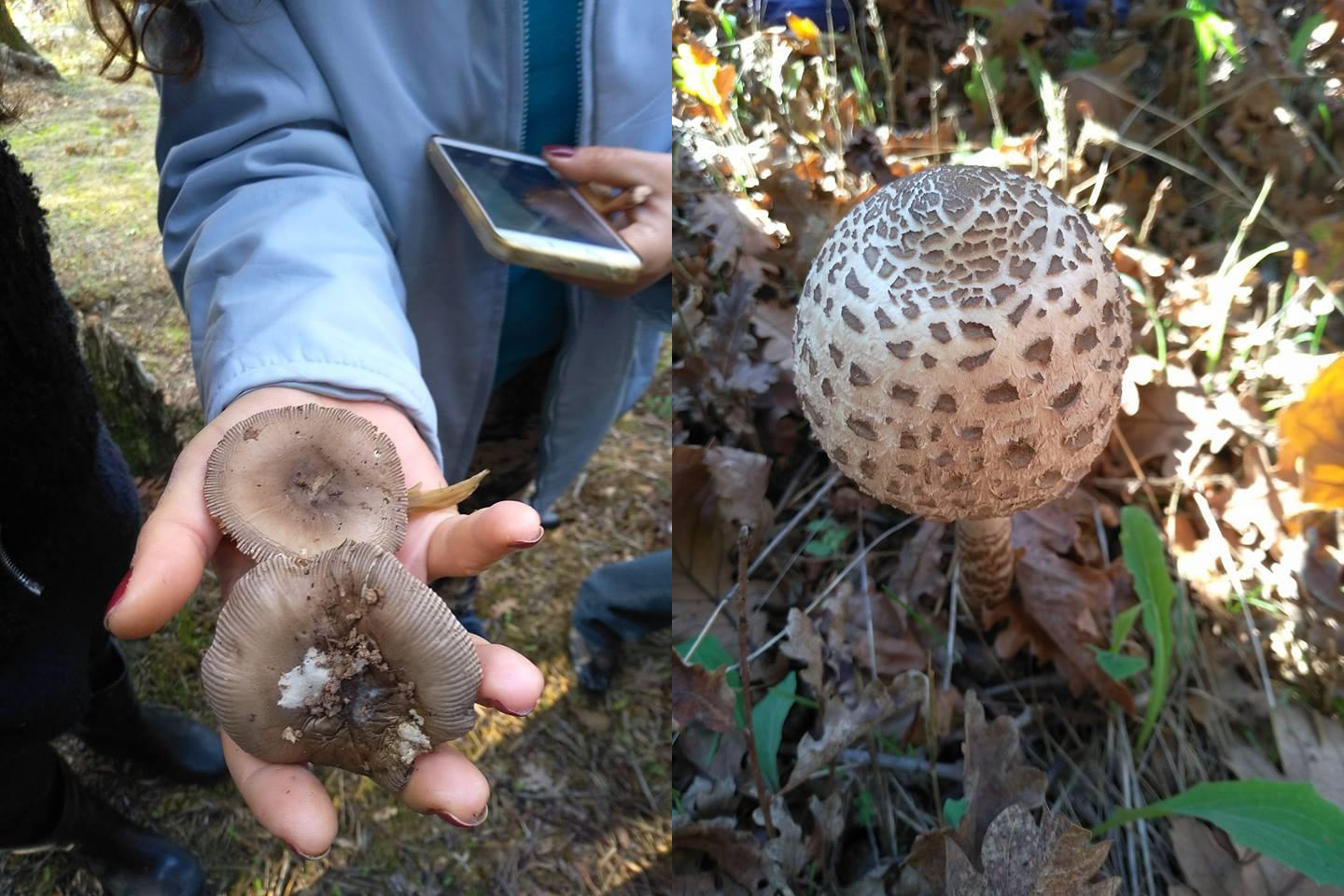

At this stage, it is great food. Later on when the spores develop, it can be used for medicine.
Fruit
| Fruit | ||
| Common English Name | Common Greek Name in
the Corfiot Dialect |
Scientific Name |
| Strawberry tree | Κούμαρα | Arbutus unedo |
| White mulberries | Μούρα Άσπρα | Morus alba |
| Black mulberries | Μούρα Μαύρα | Morus Nigra |
| Fig tree | Σύκα | Ficus carica |
| Jujube tree | Τζίτζιφα | Ziziphus jujube |
| Pomegranate | Ρόδι | Punica grannatum |
| Damson plum | Κάσσια | Prunus domestica subsp. insititia |
| Wild plum | Αγριοκορομηλιά | Prunus Americana |
| Prickly pear | Παυλόσυκα | Opuntia ficus-indica |
| Blackberries | Βατόμουρα | Rubus sanctus |
Fig cakes are still loved in Corfu! Women make them at the end of summer when figs are available and people store them to enjoy during the Christmas season. If it is a good year for figs, they are enjoyed all over the winter with a glass of tsipouro or ouzo. Maybe too sweet for modern diets, but in the past these were the only sweets people enjoyed on special occasions.
Fig Cakes – Sikomaides
Ingredients for 6 medium-sized fig cakes:
2 kilos fresh figs
2-3 kilos grapes
2 tablespoons black pepper
6 tablespoons ouzo
2 teaspoons dried aniseeds
In other recipes I’ve seen, ground cloves and ground laurel leaves are added as spices.
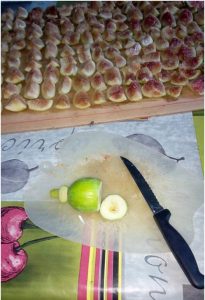
Make a cross with a sharp knife on the upper part of the figs and open them up in four without separating them completely. Lay them on a tray covered with muslin. Leave them under the sun for about a week or until they are dried. Turn them upside down, so that they will dry from all sides. Keep them in the house during the night.

Boil water and dip the figs in for a minute. Dry them well with a towel and put them in the oven at a low temperature (100˚ C) for 15 minutes or keep them in the shade in the fresh air for four more days.
Cut them into very small pieces with scissors. Some of the people I spoke with sprinkle ouzo, mix them well and leave overnight.
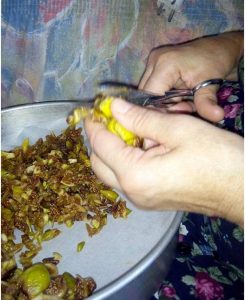
Hand squeeze the grapes over a sieve and take the juice. Grape must (thick grape juice including pulp) can be used instead. Sugar, too.
Put all the ingredients in a bowl and knead well until you have a thick paste.
Pour ouzo onto a plate. Take some paste and shape it by hand into a flat cake and then bath it in ouzo on both sides.

Leave the cakes in the sun covered with muslin for 7-8 days. When the cakes are sufficiently dry, wrap them in fig or walnut leaves and tie them with a thread (preferably a natural grass)
The sikomaides are now ready to eat or store in a cupboard.
Jujube
Jujube is another fruit that Corfiots love to store for their winter glass of tsipouro by the fire. They are eaten fresh in autumn and they are also dried under the sun to be preserved.
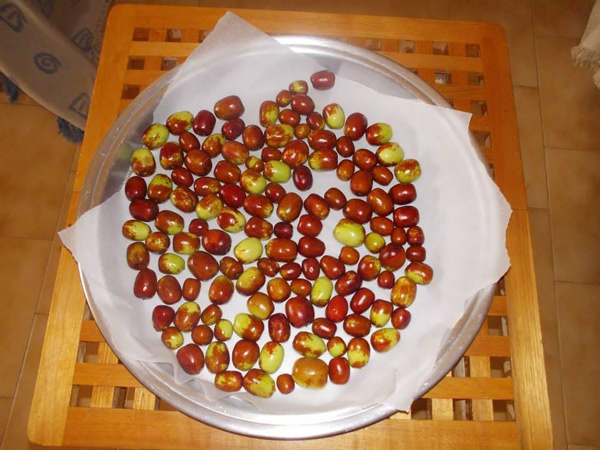
Dry under the sun, covered with a cheesecloth for three days. Put in the oven at 125 degrees Celsius with the door slightly open until shrunk and fully dried.
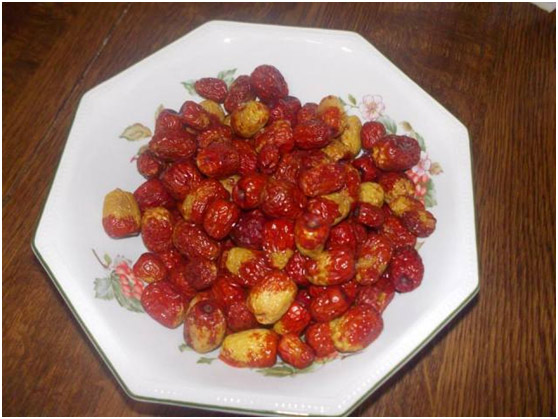
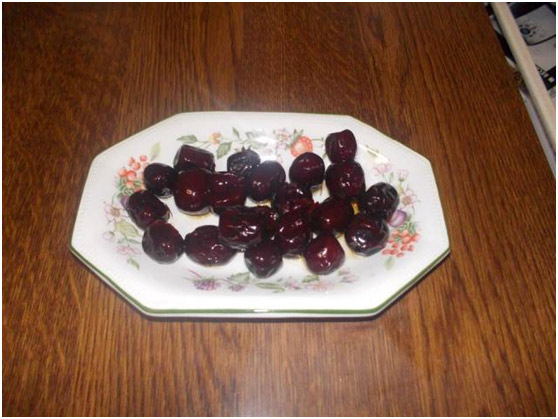
Dried jujube can be preserved in ouzo, sprinkled with fennel seed.
“My mother used to wash gingoles (jujube) with grape must. Then, she spread them in a baking tray, added fennel seed and baked them in very low oven until dried. Then, she preserved them in glass jars.” (Eleni Zoumpou)
Koumara, Strawberry tree fruit
